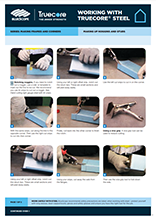Warning
Please be advised this website is for internal review purposes only and is not to be distributed until advised.
Please be advised this website is for internal review purposes only and is not to be distributed until advised.
Modifying a window opening, or moving a door, can be done efficiently on-site, however, the frame fabricator’s approval should be given prior to commencing any work.
Once approvals have been given, the modification process is as follows for moving an opening:
Note other strengthening work may need to be carried out, particularly for load-bearing walls. Always follow frame fabricators engineered instructions.
For information on how to make a LGS noggin, see TRUECORE® steel's instructions in the Resources below. Also see our topic and video, Making New Noggins.

This document provides step-by-step instructions and images to help you make up noggins and studs.

See how to use an adjustable commercial noggin and how to make a noggin from steel or timber.

Learn how to replace a damaged stud in 7 easy steps.